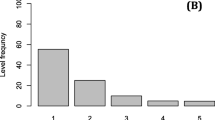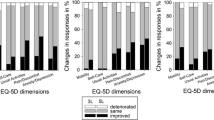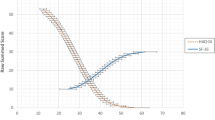Abstract
Introduction
Mapping algorithms are increasingly being used to predict health-utility values based on responses or scores from non-preference-based measures, thereby informing economic evaluations.
Objectives
We explored whether predictions in the EuroQol 5-dimension 3-level instrument (EQ-5D-3L) health-utility gains from mapping algorithms might differ if estimated using differenced versus raw scores, using the Roland–Morris Disability Questionnaire (RMQ), a widely used health status measure for low back pain, as an example.
Methods
We estimated algorithms mapping within-person changes in RMQ scores to changes in EQ-5D-3L health utilities using data from two clinical trials with repeated observations. We also used logistic regression models to estimate response mapping algorithms from these data to predict within-person changes in responses to each EQ-5D-3L dimension from changes in RMQ scores. Predicted health-utility gains from these mappings were compared with predictions based on raw RMQ data.
Results
Using differenced scores reduced the predicted health-utility gain from a unit decrease in RMQ score from 0.037 (standard error [SE] 0.001) to 0.020 (SE 0.002). Analysis of response mapping data suggests that the use of differenced data reduces the predicted impact of reducing RMQ scores across EQ-5D-3L dimensions and that patients can experience health-utility gains on the EQ-5D-3L ‘usual activity’ dimension independent from improvements captured by the RMQ.
Conclusion
Mappings based on raw RMQ data overestimate the EQ-5D-3L health utility gains from interventions that reduce RMQ scores. Where possible, mapping algorithms should reflect within-person changes in health outcome and be estimated from datasets containing repeated observations if they are to be used to estimate incremental health-utility gains.

Similar content being viewed by others
References
National Institute for Health and Care Excellence. Guide to the methods of technology appraisal. London: NICE; 2013.
Longworth L, Rowen D. NICE DSU Technical Support Document 10: the use of mapping methods to estimate health state utility values. London: NICE; 2011.
Dakin H. Review of studies mapping from quality of life or clinical measures to EQ-5D: an online database. Health Qual Life Outcomes. 2013;11:151.
Brazier J, Yang Y, Tsuchiya A, et al. A review of studies mapping (or cross walking) non-preference based measures of health to generic preference-based measures. Eur J Health Econ. 2010;11:215–25.
Kopec JA. Measuring functional outcomes in persons with back pain: a review of back-specific questionnaires. Spine. 2000;25:3110–4.
Khan KA, Madan J, Petrou S, et al. Mapping between the Roland Morris Questionnaire and generic preference-based measures. Value Health. 2014;17:686–95.
Lamb SE, Lall R, Hansen Z, Castelnuovo E, et al. A multicentred randomised controlled trial of a primary care-based cognitive behavioural programme for low back pain. The Back Skills Training (BeST) trial. Health Technol Assess. 2010;14(41):1–253, iii–iv.
Russell I, Underwood M, Brealey S, et al. United Kingdom back pain exercise and manipulation (UK BEAM) randomised trial: cost effectiveness of physical treatments for back pain in primary care. BMJ. 2004;329:1381.
Gray AM, Rivero-Arias O, Clarke PM. Estimating the association between SF-12 responses and EQ-5D utility values by response mapping. Med Decis Mak. 2006;26:18–29.
Rivero-Arias O, Ouellet M, Gray A, et al. Mapping the Modified Rankin Scale (mRS) measurement into the generic EuroQol (EQ-5D) health outcome. Med Decis Mak. 2010;30:341–54.
Longworth L, Rowen D. Mapping to obtain EQ-5D utility values for use in NICE health technology assessments. Value Health. 2013;16:202–10.
Chuang L-H, Whitehead SJ. Mapping for economic evaluation. Br Med Bull. 2011;101:1–15.
Chapman JR, Norvell DC, Hermsmeyer JT, et al. Evaluating common outcomes for measuring treatment success for chronic low back pain. Spine. 2011;36:S54–68.
Savigny P, Watson P, Underwood M. Early management of persistent non-specific low back pain: summary of NICE guidance. BMJ. 2009;338:b1805.
Acknowledgements
The authors thank all study investigators and participants for their role in collecting the primary data.
Author contributions
JM, KAK, SP: study concept and design. SP, SEL: acquisition of data. All authors participated in the analysis and interpretation of the data and the preparation of the manuscript.
Author information
Authors and Affiliations
Corresponding author
Ethics declarations
Although no funding directly supported this study, the authors benefitted from facilities funded through the Birmingham Science City Translational Medicine Clinical Research and Infrastructure Trials Platform, with support from Advantage West Midlands (AWM) and the Wolfson Foundation.
Conflict of interest
J Madan, KA Khan, S Petrou and SE Lamb have no conflicts of interest.
Data availability statement
This study uses data from two published clinical trials. For access to these data, please contact the corresponding authors of the relevant publications. The models used to analyse these data and generate the results reported in this study are available from the corresponding author on request.
Rights and permissions
About this article
Cite this article
Madan, J., Khan, K.A., Petrou, S. et al. Can Mapping Algorithms Based on Raw Scores Overestimate QALYs Gained by Treatment? A Comparison of Mappings Between the Roland–Morris Disability Questionnaire and the EQ-5D-3L Based on Raw and Differenced Score Data. PharmacoEconomics 35, 549–559 (2017). https://doi.org/10.1007/s40273-016-0483-z
Published:
Issue Date:
DOI: https://doi.org/10.1007/s40273-016-0483-z




